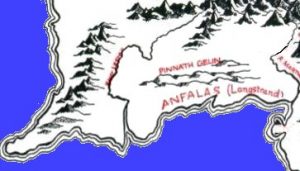Q: In What Language Are the Names from “Tal-Elmar” Given?
ANSWER: “Tal-Elmar” is a short story or novella that J.R.R. Tolkien began writing in the 1950s. He abandoned the tale after making a start on it. According to Christopher Tolkien, his father wrote a note 13 years later in which he said:
Tal-Elmar.
Beginnings of a tale that sees the Numenoreans from the point of view of the Wild Men. It was begun without much consideration of geography (or the situation as envisaged in The Lord of the Rings). But either it must remain as a separate tale only vaguely linked with the developed Lord of the Rings history, or – and I think so – it must recount the coming of the Numenoreans (Elf-friends) before the Downfall, and represent their choice of permanent havens. So the geography must be made to fit that of the mouths of Anduin and the Langstrand.
The identity of the “Wild Men” has been debated among Tolkien’s readers. My point of view is that they are the southernmost branch of those peoples from whom came the Folk of Haleth in the Second Age, the Men of Bree, the Gwathuirim, the Dunlendings, and the Dead Men of Dunharrow. In the story, these men are described as “short” and “swarthy” (dark-skinned), which are not very specific; however, there are similar descriptions for the Dunlendings and related peoples.
If we accept for the sake of discussion that the Wild Men of “Tal-Elmar” are related to the Dunlendings, can we determine that their language is related to that of the Dunlendings? Probably not. The story itself suggests that the various tribes’ dialects drifted apart relatively quickly. Hence, thousands of years later the Dunlendings’ name for the Rohirrim, Forgoil (“strawheads”), may not be related at all to any of the words Tolkien devised for “Tal-Elmar”.

Another place-name is Ishmalog, a valley to the east of the hills of Agar. According to the story, the western short swarthy folk, led by a North King, defended their lands against the incursions of a taller, fair-skinned people whom they called the Fell Folk. Buldar from the Hills of Agar fought in the army of the North King at the Battle of Ishmalog, in which many of the Fell Folk were slain or captured. Buldar took a woman of the Fell Folk, Elmar, as his wife. She bore him several children, of whom the youngest was a son, Hazad, who in turn had 17 sons — the youngest of which he named Tal-Elmar because he was fair-skinned like his grandmother.
It seems tempting to associate the name Ishmalog with the Anduin. There are several reasons why this may make sense. First, in an aside to himself Tolkien implies that North King (previously called the Fourth King in an earlier draft of the text) was (probably) Sauron. Secondly, if the green hills of Agar are indeed in or near the Langstrand, then the southern Vales of Anduin would be the only route by which Men of Rhovanion could reach that area. Third, the vales of Anduin would have been a strategic region between Mordor and the eastern lands requiring defense againt incursions from the north.
When Tal-Elmar sees the Numenorean ships he compares them to the legendary “swwns of” Gorbelgod. The reference may perhaps be to swan-ships of the Elves. Curiously, there is no mention of the Elves dwelling nearby, which is odd considering that the Elf-haven of Edhellond was supposedly situation near Morthond throughout the Second Age.
Agar’s people call the Numenoreans Go-hilleg. The term is not translated, although it might mean something like “Tall Men”, “High Men”, “Men of the Sea’, etc.
The Master of Agar is named Mogru. He is short, fat, and mean-spirited. A year prior to the tale he had sent Tal-Elmar north (or inland) to spy on the nearby village of Udul, whose people are related to the people of Agar.
The Numenoreans whom Tal-Elmar meets conclude he must be related to their mortal kinsmen in Middle-earth. Hence, the Fell Folk must be a group of people related to the Marachians or Beorians of the First Age. Since the story is unfinished and Tolkien never adapted it to fit the geography of Middle-earth as established in The Lord of the Rings it is impossible to identify the language of the Men of Agar with any specific region or group. It is probably fair to say that the language is related to the pre-Numenorean place-names spread across Gondor (such as Erech) and possibly also the ancestor language of the Dunlendings.
In addition to their physical appearance, the Men of Agar resembled the Gwathuirim in that their town was surrounded by a wall (but this would be characteristic of many peoples), in that they were relatively isolationist (losing contact even with their relatives and neighbors in Udul), and in that they served Sauron.
The story of “Tal-Elmar” would have been set between the time that the Numenoreans began building fortresses and taking slaves (Circa Second Age year 1800) and the founding of Gondor (Second Age year 3320). That is a period of approximately 1500 years.
# # #
Have you read our other Tolkien and Middle-earth Questions and Answers articles?
